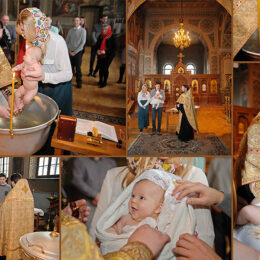MEGIDDO PRISON, Israel (AP) – Israeli prisoner Ramil Razilo was removing rubble from the planned site of a new prison ward when his shovel uncovered the edge of an elaborate mosaic, unveiling what Israeli archaeologists said Sunday may be the Holy Land’s oldest church.
The discovery of the church in the northern Israeli town of Megiddo, near the biblical Armageddon, was hailed by experts as an important discovery that could reveal details about the development of the early church in the region. Archaeologists said the church dated from the third century, decades before Constantine legalized Christianity across the Byzantine Empire.
“What’s clear today is that it’s the oldest archaeological remains of a church in Israel, maybe even in the entire region. Whether in the entire world, it’s still too early to say,” said Yotam Tepper, the excavation’s head archaeologist.
Israeli officials were giddy about the discovery, with Prime Minister Ariel Sharon calling the church “an amazing story.”
Vatican officials also hailed the find.
“A discovery of this kind will make Israel more interesting to all Christians, for the church all over the world,” said Archbishop Pietro Sambi, the Vatican envoy to Jerusalem. “If it’s true that the church and the beautiful mosaics are from the third century, it would be one of the most ancient churches in the Middle East.”
Razilo, who is serving a two-year sentence for traffic violations, was one of about 50 prisoners brought into the high-security Megiddo Prison to help excavate the area before the construction of new wards for 1,200 Palestinian prisoners.
Razilo was shocked to uncover the edge of the mosaic. The inmates worked for months to uncover all the parts of the mosaic – the floor of the church, he said.
“We continued to look and slowly we found this whole beautiful thing,” said Razilo, who used a sponge and a bucket of water to clean dirt off the uncovered mosaics Sunday.
Two mosaics inside the church – one covered with fish, an ancient Christian symbol that predates the cross – tell the story of a Roman officer and a woman named Aketous who donated money to build the church in the memory “of the god, Jesus Christ.”
Pottery remnants from the third century, the style of Greek writing used in the inscriptions, ancient geometric patterns in the mosaics and the depiction of fish rather than the cross indicate that the church was no longer used by the fourth century, Tepper said.
The church’s location, not far from the spot where the New Testament says the final battle between good and evil will take place, also made sense because a bishop was active in the area at the time, said Tepper, who works with the Israel Antiquities Authority.
The inscription, which specifies that Aketous donated a table to the church, indicates the house of worship predated the Byzantine era, when Christians began using altars in place of tables in their rituals, Tepper said. Remnants of a table were uncovered between the two mosaics.
The building – most of which was destroyed – also was not built in the Basilica style that was standard under the Byzantines, he added.
Stephen Pfann, a biblical scholar and professor at the Holy Land University, said the second and third centuries were transitional periods where people sought to define their religious beliefs and modes of worship. Iconography and inscriptions found in Nazareth and Caperneum – places where Jesus lived – show that people went there to worship, although most did so secretly.
“This was a time of persecution and in this way it is quite surprising that there would be such a blatant expression of Christ in a mosaic, but it may be the very reason why the church was destroyed,” Pfann said.
The dig will continue as archaeologists try to uncover the rest of the building and its surroundings, including what they believe could be a baptismal site, Tepper said.
Joe Zias, an anthropologist and former curator with the antiquities authority, questioned the dating of the find, saying there is no evidence of churches before the fourth century. The building may have been in use earlier, but most likely not for Christian religious purposes, he said.
“They’re going to be hard, hard-pressed to prove it … because the evidence argues otherwise,” Zias said.




I just posted on this news, highlighting the fact that the inscription says “the God Jesus Christ,” which confirms the earliest confession of the deity of Christ in the Church, contrary to liberal revisionist propaganda like The DaVinci Code.
Actually, the earliest expression is the Apostle Paul when he appropriated the Old Testament term “Lord” and applied it to Jesus Christ. Lord, to the ear of the first century Jew, meant “God”. “Hear O Israel, the Lord your God is one God.”
In the synagogues before and during the time of Jesus and Paul, those who read the Bible (which at the time was what we now call the Old Testament) aloud to the congregations were instructed by notes in the margin to use the word “Adonai” (“Lord”) instead of the actual name of God which was written in the text. To speak the name of God directly was understood as violating its holiness; hence the “workaround.”
BTW, this is also the origin of a false name of God, Jehovah. Hebrew is written as consonants with the vowels indicated above and below the consonants with little marks called pointing. In the earliest Hebrew manuscripts of the Old Testament that include pointing, the consonants that spell the name of God — yhwh — are surrounded by the pointing for the word “Adonai.” (This was another reminder to the readers to use “Adonai” instead of the actual name of God.) Later Christian readers who weren’t aware of this custom simply read the vowels and consonants together and came up with the name “Jehovah.” Remember this the next time you are visited by the Witnesses: The name of their god is the result of centuries-old scholarly ignorance.
There are many ways in which Jesus is identified as God in the New Testament, in addition to the Pauline references Fr. Hans mentioned. For example, in the story of the Gerasene demoniac in Matthew, Jesus charges the healed demoniac to proclaim “everything that God had done for him. And he went away and proclaimed everything Jesus had done for him.” Also in Matthew, Jesus states that “before Moses was, I am.” “I am” is one of the translations of the name yhwh; the author of Matthew is making as direct (and confrontative) identification as he can of Christ’s divinity. Jesus not only speaks the Holy Name but claims as his own. In the eyes of the crowd this is a double blasphemy, which is why they try to kill him, and it also forms the basis of the charge during Jesus’ trial that “he tried to make himself God.”
The Witnesses argue Jesus is a demigod and not THE ALMIGHTY GOD by wrongly interpreting the “word was God” of John 1:1 as “the word was (a) God”.
Does anyone know if the inscription in the Megiddo mosaic “The God, Jesus Christ” is written Ho Theos (THE God)?
Or, would anyone know of a photo of the inscriptions on the mosaic so I can take a look for myself? The only photos I’ve seen don’t include the words.
Here’s a link to the inscription. It says “God” in Greek but the “Jesus” (Isous) is harder to make out. Full article here.